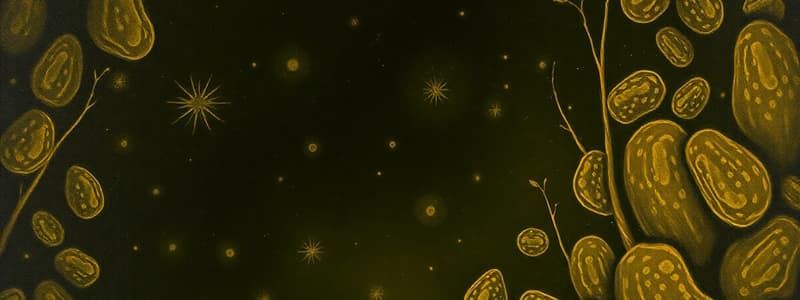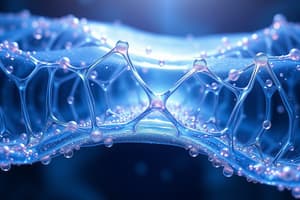Podcast
Questions and Answers
How do ionic detergents disrupt bonds?
How do ionic detergents disrupt bonds?
- By creating hydrophobic interactions with the ions.
- By directly neutralizing the charges of the ions.
- By forming micelles that sequester ions.
- By disrupting ionic and hydrogen bonds. (correct)
Nonionic detergents possess a net charge, allowing for strong electrostatic interactions.
Nonionic detergents possess a net charge, allowing for strong electrostatic interactions.
False (B)
What is the significance of the Critical Micelle Concentration (CMC) in the context of detergent behavior?
What is the significance of the Critical Micelle Concentration (CMC) in the context of detergent behavior?
Below the CMC, detergents exist as single molecules; above the CMC, they form micelles.
In phospholipid synthesis, the enzyme __________ converts fatty acid + CoA into fatty acyl-CoA.
In phospholipid synthesis, the enzyme __________ converts fatty acid + CoA into fatty acyl-CoA.
Match the following processes in phospholipid synthesis with their corresponding enzymes:
Match the following processes in phospholipid synthesis with their corresponding enzymes:
Which of the following is NOT a method of covalent binding of proteins to lipids in biomembranes?
Which of the following is NOT a method of covalent binding of proteins to lipids in biomembranes?
The hydrophobic core of the plasma membrane bilayer facilitates the unassisted movement of water-soluble substances.
The hydrophobic core of the plasma membrane bilayer facilitates the unassisted movement of water-soluble substances.
Name the three organelles enclosed by two membranes.
Name the three organelles enclosed by two membranes.
Lipid-anchored proteins are connected to one leaflet of the plasma membrane by covalently attached ________ chains.
Lipid-anchored proteins are connected to one leaflet of the plasma membrane by covalently attached ________ chains.
Match the following membrane lipids with their descriptions:
Match the following membrane lipids with their descriptions:
Which of the following is a characteristic of plasmalogens?
Which of the following is a characteristic of plasmalogens?
Peripheral proteins are integrated into the hydrophobic core of the cell membrane.
Peripheral proteins are integrated into the hydrophobic core of the cell membrane.
Which type of molecule is responsible for determining human blood groups (O, A, and B)?
Which type of molecule is responsible for determining human blood groups (O, A, and B)?
Which of the following lipid components contributes to membrane fluidity based on temperature?
Which of the following lipid components contributes to membrane fluidity based on temperature?
E. coli plasma membranes contain phosphatidylcholine, sphingomyelin, and cholesterol.
E. coli plasma membranes contain phosphatidylcholine, sphingomyelin, and cholesterol.
From what fatty acid are prostaglandins derived?
From what fatty acid are prostaglandins derived?
Most transmembrane proteins have α-helices with hydrophobic side chains interacting with the bilayer's fatty acyl chains via ______ forces.
Most transmembrane proteins have α-helices with hydrophobic side chains interacting with the bilayer's fatty acyl chains via ______ forces.
Which phospholipase cleaves the ester bond at the C2 position of a phospholipid molecule?
Which phospholipase cleaves the ester bond at the C2 position of a phospholipid molecule?
Match the following lipids with their characteristics:
Match the following lipids with their characteristics:
In what organisms or cellular compartments are porins typically found?
In what organisms or cellular compartments are porins typically found?
What property of detergents allows them to be used to extract membrane proteins?
What property of detergents allows them to be used to extract membrane proteins?
Which of the following characteristics is NOT a feature of the fluid mosaic model of biomembranes?
Which of the following characteristics is NOT a feature of the fluid mosaic model of biomembranes?
Peripheral proteins are directly inserted into the hydrophobic core of the plasma membrane.
Peripheral proteins are directly inserted into the hydrophobic core of the plasma membrane.
What property of cholesterol allows it to contribute to membrane fluidity?
What property of cholesterol allows it to contribute to membrane fluidity?
The three organelles enclosed by two membranes are the nucleus, mitochondria, and ______.
The three organelles enclosed by two membranes are the nucleus, mitochondria, and ______.
Match each lipid modification with the type of covalent attachment involved:
Match each lipid modification with the type of covalent attachment involved:
Which lipid is responsible for determining human blood groups (O, A, and B)?
Which lipid is responsible for determining human blood groups (O, A, and B)?
Plasmalogens are characterized by what type of linkage at the C-1 position of glycerol?
Plasmalogens are characterized by what type of linkage at the C-1 position of glycerol?
Which of the following statements regarding membrane lipid composition and organization is correct?
Which of the following statements regarding membrane lipid composition and organization is correct?
Phospholipases C and D cleave ester bonds at C1 and C2 of glycerol, respectively.
Phospholipases C and D cleave ester bonds at C1 and C2 of glycerol, respectively.
Prostaglandins are derived from what specific fatty acid?
Prostaglandins are derived from what specific fatty acid?
Lipid droplet formation initiates with the accumulation of cholesterol esters and ______ within the hydrophobic core of the lipid bilayer.
Lipid droplet formation initiates with the accumulation of cholesterol esters and ______ within the hydrophobic core of the lipid bilayer.
Match the following enzymes with their role in phospholipid synthesis:
Match the following enzymes with their role in phospholipid synthesis:
What structural feature do most transmembrane proteins utilize to interact with the hydrophobic core of the lipid bilayer?
What structural feature do most transmembrane proteins utilize to interact with the hydrophobic core of the lipid bilayer?
Annular phospholipids form a lipid layer directly surrounding peripheral membrane proteins.
Annular phospholipids form a lipid layer directly surrounding peripheral membrane proteins.
What is the function of porins?
What is the function of porins?
What is the general term for molecules which can solubilize membrane proteins due to their amphipathic nature?
What is the general term for molecules which can solubilize membrane proteins due to their amphipathic nature?
Which of the following is NOT a proposed mechanism for the transport of cholesterol and phospholipids between membranes?
Which of the following is NOT a proposed mechanism for the transport of cholesterol and phospholipids between membranes?
Flashcards
Hydrophobic Interactions
Hydrophobic Interactions
Interactions where nonpolar molecules avoid water and associate with each other.
Critical Micelle Concentration (CMC)
Critical Micelle Concentration (CMC)
The concentration at which detergents start to form micelles.
Ionic Detergents
Ionic Detergents
Detergents like SDS that disrupt ionic and hydrogen bonds.
Phosphatidic Acid Formation
Phosphatidic Acid Formation
Signup and view all the flashcards
Lipid Transfer Mechanisms
Lipid Transfer Mechanisms
Signup and view all the flashcards
Fucose
Fucose
Signup and view all the flashcards
Cholesterol
Cholesterol
Signup and view all the flashcards
Phospholipase
Phospholipase
Signup and view all the flashcards
Prostaglandins
Prostaglandins
Signup and view all the flashcards
Transmembrane proteins
Transmembrane proteins
Signup and view all the flashcards
Annular Phospholipids
Annular Phospholipids
Signup and view all the flashcards
Porins
Porins
Signup and view all the flashcards
Detergents
Detergents
Signup and view all the flashcards
Fluid Mosaic Model
Fluid Mosaic Model
Signup and view all the flashcards
Hydrophobic Core
Hydrophobic Core
Signup and view all the flashcards
Lipid Anchored Proteins
Lipid Anchored Proteins
Signup and view all the flashcards
Peripheral Proteins
Peripheral Proteins
Signup and view all the flashcards
Phospholipid Structure
Phospholipid Structure
Signup and view all the flashcards
Plasmalogen
Plasmalogen
Signup and view all the flashcards
Sphingophospholipid
Sphingophospholipid
Signup and view all the flashcards
Gangliosides
Gangliosides
Signup and view all the flashcards
Glycolipids
Glycolipids
Signup and view all the flashcards
Covalent Binding to Lipids
Covalent Binding to Lipids
Signup and view all the flashcards
Lipid Composition in E. coli
Lipid Composition in E. coli
Signup and view all the flashcards
Cholesterol in Membranes
Cholesterol in Membranes
Signup and view all the flashcards
Phosphatidylcholine
Phosphatidylcholine
Signup and view all the flashcards
Palmitoylation
Palmitoylation
Signup and view all the flashcards
Sphingolipids
Sphingolipids
Signup and view all the flashcards
Sphingomyelin Thickness
Sphingomyelin Thickness
Signup and view all the flashcards
Phospholipase A1 & A2
Phospholipase A1 & A2
Signup and view all the flashcards
Prostaglandins Source
Prostaglandins Source
Signup and view all the flashcards
Lipid Droplet Formation
Lipid Droplet Formation
Signup and view all the flashcards
Transmembrane Protein Structure
Transmembrane Protein Structure
Signup and view all the flashcards
Micelle Formation
Micelle Formation
Signup and view all the flashcards
Cholesterol Transport Mechanisms
Cholesterol Transport Mechanisms
Signup and view all the flashcards
Charge in Protein Assembly
Charge in Protein Assembly
Signup and view all the flashcards
Porins Structure
Porins Structure
Signup and view all the flashcards
Detergent Action
Detergent Action
Signup and view all the flashcards
Study Notes
Fluid Mosaic Model of Biomembranes
- Biomembranes are composed of a phospholipid bilayer with proteins embedded.
- The bilayer's hydrophobic core prevents the movement of most water-soluble substances.
- Proteins are either covalently or non-covalently attached.
- Some proteins are anchored via hydrocarbon chains.
- Others associate with the membrane through non-covalent interactions.
- Covalent binding occurs via GPI anchors, palmitoylation, myristoylation, or prenylation.
Study of Phospholipid Bilayers
- Organic solvent treatment separates lipids, proteins, and oligosaccharides.
- In water, the phospholipids form planar layers or liposomes.
- Only the nucleus, mitochondria, and chloroplasts are enclosed by two membranes.
Membrane Lipids: Phospholipids
- Glycerophospholipids have a glycerol backbone, 2 fatty acid tails, a phosphate group, and a variable group (-OR).
- Common head groups include phosphatidylcholine, phosphatidylethanolamine, and phosphatidylserine.
- Some glycerophospholipids possess ether-linked fatty acids.
Other Lipid Components
- Plasmalogens contain one ester-linked fatty acyl chain and one ether-linked long hydrocarbon chain, similar to ether linkage at C1 of glycerol.
- Glycolipids have a sphingosine backbone, a fatty acid, and a phosphate group. They are attached to either a monosaccharide or oligosaccharide.
- Sterols have a four-ring sterol backbone, a fatty acid, and a polar head group. Cholesterol is part of this group.
- Sphingoglycolipids have sphingosine backbone, a fatty acid, and a sugar molecule.
- Ceramides are the simplest sphingolipids.
- Cerebrosides contain a single sugar.
- Gangliosides have multiple sugars and are associated with blood group determination.
Cholesterol
- Cholesterol is an amphipathic molecule. It has both hydrophobic and hydrophilic components.
- Cholesterol contributes to membrane fluidity at different temperatures.
Membrane Proteins
- Proteins can be covalently bound to lipids, often anchored by GPI, palmitoylation, myristoylation, or prenylation.
- Peripheral membrane proteins interact with the membrane via non-covalent bonds.
Lipid Composition
- Eukaryotic membranes contain various phospholipids, including phosphatidylcholine, sphingomyelin, and cholesterol.
- Phospholipase enzymes break down phospholipids by cleaving phosphodiester bonds.
- These enzymes include phospholipase A1 and A2 (cleave at C1 and C2 respectively), and phospholipase C and D (cleave phosphodiester bonds in the head group).
- Prostaglandins are eicosanoids derived from arachidonic acid.
Lipid Droplets
- Lipid droplets accumulate cholesterol esters and triglycerides in hydrophobic cores.
Transmembrane Proteins
- Many transmembrane proteins have α-helices with hydrophobic side chains.
- These interact with the fatty acyl chains, and hydrophilic portions are shielded from hydrophobic membrane interiors.
Annular Phospholipids
- Annular phospholipids surround integral proteins within the membrane.
Charged Residues
- Charged amino acids help establish higher order structures in proteins like the T cell receptor.
Porins
- Porins form trans-membrane barrels in the outer membranes of Gram-negative bacteria, chloroplasts, and mitochondria.
Detergents
- Detergents are used to remove proteins from membranes.
Purification Challenge
- Membrane proteins are challenging to isolate due to their tight associations with lipids and other proteins.
- Detergents are used to solubilize membrane proteins.
Phospholipid Synthesis in ER Membrane
- Acyl transferases convert fatty acids to fatty acyl CoA.
- Another acyl transferase adds fatty acyl CoA to glycerol-3-phosphate, forming phosphatidic acid.
- Phosphatase removes the phosphate group to form diacylglycerol.
- Choline phosphotransferase adds phosphocholine to DAG, forming phosphatidylcholine.
Proposed Mechanisms of Transport of Cholesterol and Phospholipids
- Lipid transfer between membranes can occur via vesicles.
- Membrane-embedded proteins mediate the transfer of cholesterol and phospholipids.
- Small lipid transfer proteins also mediate transfer.
Studying That Suits You
Use AI to generate personalized quizzes and flashcards to suit your learning preferences.




